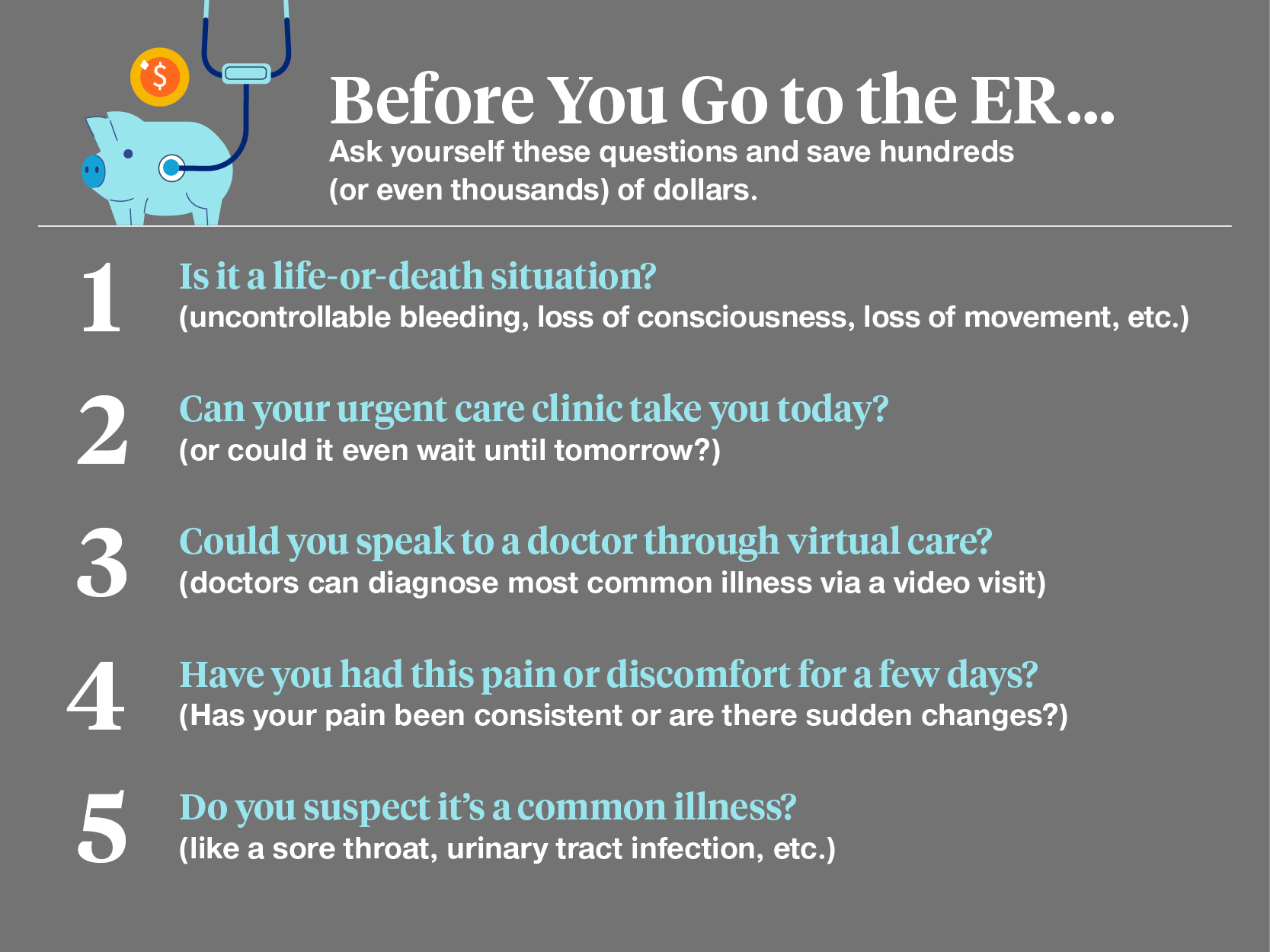6 Questions to Ask Before Going to the Emergency Room
If you’re not feeling well, before you head to the hospital, think about other medical facilities where you could be treated. It could save you hundreds of dollars or more.

Each year, millions of Americans go to the emergency room (ER). According to the Centers for Disease Control and Prevention, there are about 130 million ER visits each year. Those visits can be expensive — and are often unnecessary.
On average, people pay more than $2,000 each time they visit the emergency department for a treatable condition. But they could pay less than $200 per visit, on average, at an urgent care clinic or physician’s office.
And the same report found that two-thirds of emergency room visits are actually for non-emergencies. That means many millions of people each year are overspending on the ER when a doctor’s office or urgent care center may have been the better option.
To help you save money and avoid an unnecessary trip to the ER, we consulted doctors about 6 important questions you should ask yourself to determine whether you should go to the ER or seek care at an urgent care clinic or doctor’s office instead.
Question #1: Is there an immediate threat to my well-being?
“The emergency room environment was created to treat critical and catastrophic medical conditions fast,” says Noor Ali, M.D., a health insurance adviser. “If something needs to be taken care of immediately and it’s a question of life and death, that is absolutely when you should seek care at an emergency room.”
So how do you determine which situations are life and death? You should go to the ER if you have uncontrollable bleeding, suspect a heart attack or stroke, or notice rapid changes in your vital signs and functions. Those changes can include your blood pressure dropping or going too high, your heart rate racing or beating abnormally, a loss of consciousness, a loss of movement in your limbs, or an inability to form thoughts, says Bruce Y. Lee, M.D. He’s a professor of health policy and management at City University of New York’s School of Public Health and the Executive Director of PHICOR (Public Health Informatics, Computational, and Operations Research).
Question #2: Can your urgent care clinic get you in today? Or could it wait until tomorrow?
Urgent care is a great alternative to the emergency room. “It was created due to the burden of non-catastrophic issues in emergency rooms that were causing severe delays and hindering care for patients who were at risk of death,” says Dr. Ali. “Common conditions that used to be treated in emergency rooms but are now better treated in urgent care environments include urinary tract infections (UTIs), ear infections, and minor cuts and lacerations.”
Question #3: Could speaking to a doctor via virtual care ease your concerns?
Virtual care visits can help you save a lot of time and money.
“Virtual care providers are trained to treat common conditions from the comfort of your home, without the need to expose yourself to germs in a waiting room,” says Dr. Ali. “It’s a far more effective method. Common conditions treated via virtual care are headaches, stomachaches, ear infections, yeast infections, UTIs, and routine medication refills.”
Dr. Lee adds that although a doctor can’t touch you during a virtual visit, seeing you (on camera) is often enough, and doctors are trained to look for evidence in the face, body positioning, and more to determine what’s going on.
“Doctors are taught to ask the right questions and look for certain things to apply objective measures,” he says.

Question #4: Is this a pain or discomfort you’ve already lived with for a few days?
According to Dr. Lee, if you have sudden-onset pain or a sudden change in your pain level, that is the time to seek care at an ER — not when your pain has been consistent or hasn’t changed in weeks or months.
“Sudden change means worsening in severity or the addition of new symptoms,” says Dr. Lee.
If you’re debating whether to head to the ER, he suggests contacting your primary care doctor first, since they know you and your medical history.
“Urgent care and emergency rooms don’t know your history, and you don’t have a relationship with them,” Dr. Lee says. “It’s the big advantage of getting care from your primary doctor, who knows the details of the medications you’re taking and your medical history. They may know what’s causing your symptoms. Urgent care and ER doctors don’t have that information, which may require extra tests or time to get that information from you.”
Question #5: Do you suspect it’s a common illness (sore throat, UTI, etc.)?
Emergency rooms are designed to handle life-and-death situations — which is why they are so expensive.
“ERs have to be prepared to handle all kinds of situations, including worst-case scenarios like bleeding, emergency surgery, accidents, heart attacks, and even death, and that requires highly skilled people and specialized equipment, which is what you’re paying for,” explains Dr. Lee.
He notes that you should only use the ER if you are at imminent risk of a life-threatening situation with major potential damage. And while your sore throat or suspected UTI can feel pretty bad, those are conditions best treated at an urgent care clinic or via a virtual visit.
Question #6: Can lab work or imaging be done at a smaller local facility?
If you need imaging or additional testing to determine what’s going on with your health, you’ll be paying top dollar if it’s done in an ER.
“There are some imaging services and lab tests that are done just as effectively at smaller local specialized facilities, but at much lower rates than an emergency room,” says Dr. Ali.
For example, she says, you don’t get a mammogram at an ER, but rather at a radiology and imaging center whose core purpose is diagnostic mammograms.
“Another example is lab work,” she says. “Opt to get lab work done at big, national lab chains such as Quest or Labcorp. The ER may bill much higher for the same test, due to the urgent turnaround time for the results.”
Additional sources
Stats on emergency room visits: Centers for Disease Control and Prevention
Comparing costs of specific medical services by metro area: Health Care Cost Institute